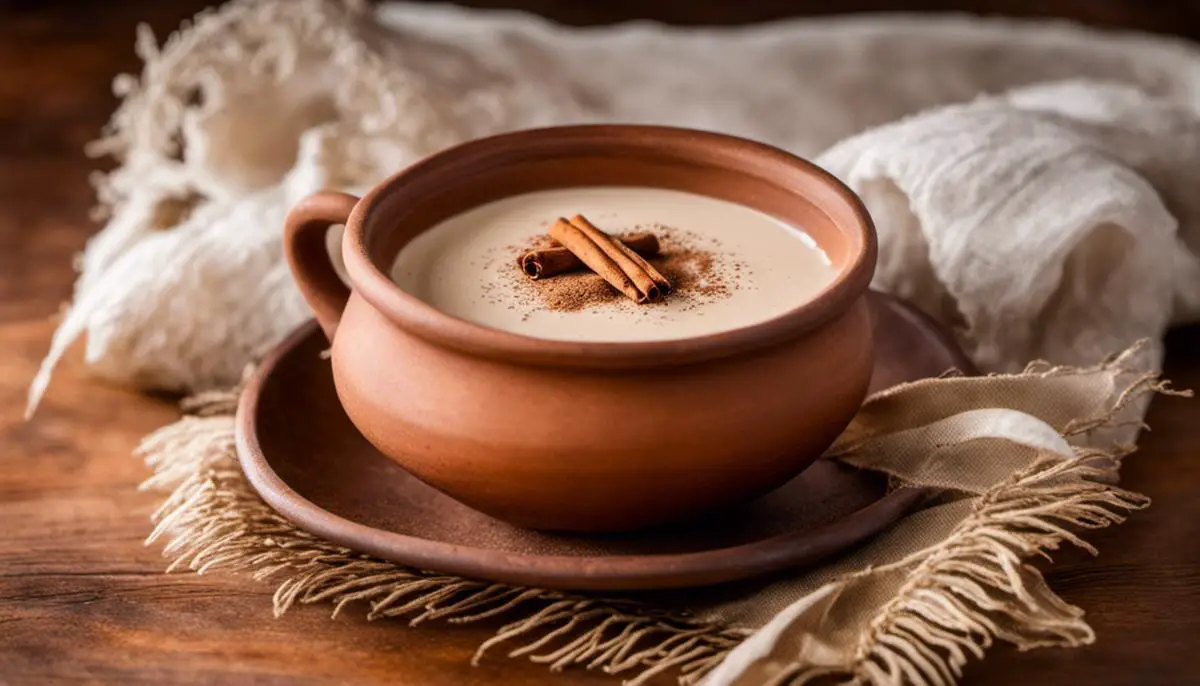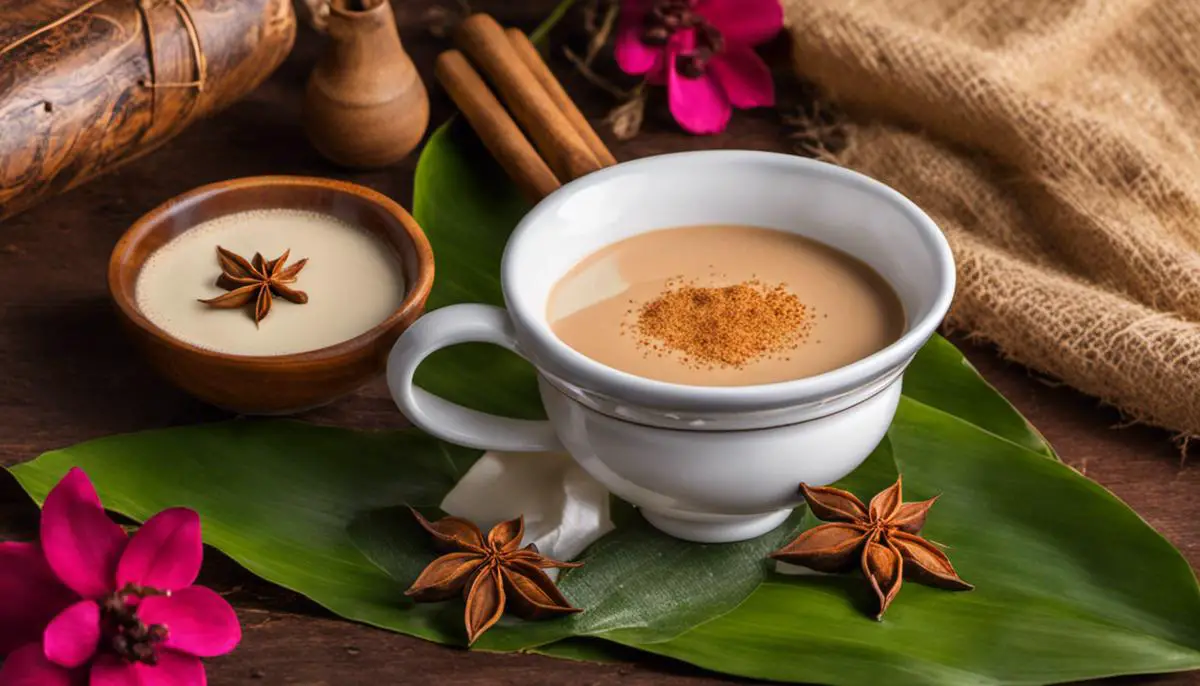
Atole, a traditional beverage hailing from Mexico, has long been a culinary staple and a symbol of cultural significance steeped in history. This captivating brew, prepared primarily from corn dough or masa, unfolds a narrative that intertwines ceremonial traditions, culinary adaptations, and wellness aspects. Its historical roots draw us back to time when atole was not only a beverage but also a congregational symbol in myriad rituals and festivities. The versatility of atole is clearly showcased through the numerous variations that have been conjured with the addition of multifarious elements like chocolate, fruits, and nuts. By juxtaposing traditional preparations with modern cooking techniques, this exploration of atole shines light on both the authenticity and the ingenuity inherent in its creation. Immersing ourselves in this journey, we will also uncover the delightful palette of dishes that harmonize perfectly with this comforting brew, opening new horizons for food enthusiasts.
Historical Significance of Atole
A Bowlful of Heritage: Understanding Atole’s Cultural Identity
Brace for a culinary journey into the heart of Mexican gastronomy, as we dive into the history, the cultural significance, and the sweet allure of Atole. This delightfully warm and comforting beverage, often consumed at breakfast or during the wee hours of a chilly night, carries within its wholesome embrace, a millennia-old cultural heritage.
Originating from Mexico’s indigenous culture, Atole was part of the Mesoamerican staple diet even before the escalation of Spanish conquest. Rooted deeply in Nahuatl tradition, “Atole,” a distortion of the Nahuatl word “ātōlli,” translates to ‘watery.’ True to its name, Atole showcases a unique blend of water (or milk), masa (corn dough), piloncillo (raw cane sugar), cinnamon, vanilla, and sometimes chocolate or fruit flavors. However, Atole isn’t merely about its ingredients; it’s about evoking joy through the magic stirred into a tamale meal, or a serving of buñuelos.
Atole’s ceremonial stance permeates various Mexican festivals, signifying its enduring presence in the country’s cultural tapestry. During Día de los Muertos, spirits are believed to return to the earth, and Atole serves as a comforting, nourishing offering to the visiting souls. Similarly, Las Posadas, a nine-day Christmas celebration, sees families gather to share a heartwarming bowl of Atole, symbolizing unity and brotherhood. Thus, with every sip of this delightful beverage, one partakes in an age-old tradition that links back generations.
Many regions have their unique take on Atole, reflecting the country’s geographical and cultural diversity. Whether it’s the chocolate-infused ‘Champurrado’ in Central Mexico, the fruit flavored ‘Atole de fresa’ of Michoacán, or the savory ‘Chileatole’ of Puebla, every rendition tells a local tale.
The experience of savoring a warm, nourishing cup of Atole draws parallels with love being ladled into a bowl. It is a tactile, tangible connection to a proud, ancient heritage. This storied drink breaks the barriers of class or contemporary dietary concerns, serving as a testament to the inclusivity of Mexican cuisine. Atole is more than a beverage- it’s an immortal symbol of unity that beautifully encapsulates the effervescent spirit of Mexico.
Today, each pot of Atole brewed in a Mexican kitchen gently whispers age-old tales of departure and return, of struggle and sacrifices, of love and unity. So, the next time the scent of sweet, simmering Atole fills the air, remember- you are not just stirring a corn drink, you’re stirring up an era, a tradition, and a cultural heritage.

Ingredients and Variations of Atole
Capturing creative and dynamic element is vital in making an authentic atole unique and special.
This popular Mexican drink, which already carries a rich legacy of cultural significance, provides the perfect canvas for culinarians and lovers of Mexican cuisine to explore their inventiveness.
Yet, it is worth remembering that the beauty of atole lies within its simplicity and cultural essence.
Striking that right balance between honoring its roots and infusing genuine individuality can culminate in an atole that does more than just pleasing the palate; it narrates a tale, a celebration of cultural heritage and culinary adventure.
Atole, traditionally, is a mixture of masa (corn dough), water or milk, sweeteners like piloncillo (unrefined whole cane sugar), and often flavored with fruits, nuts, or chocolate.
This warm beverage, in its elemental form, presents an incredibly versatile base that enables one to experiment with the flavors without muting its historical essence.
Atole’s thick, creamy texture lends itself beautifully to the whims of flavorful creativity.
One could think about infusing it with a bit of bourbon or rum during the cold months, rendering homage to global popular culture while keeping the soul of atole intact.
This unique touch could make the family gatherings a bit more heartwarming and festive.
Layering flavors in atole also has immense potential.
A hint of cinnamon can elevate the delicate notes of the classic chocolate-infused atole, called Champurrado.
Meanwhile, a dollop of freshly whipped cream topped with a sprinkle of nutmeg might take the richness even further.
The versatility of fruits also cannot be overlooked.
For the berry lovers, a refreshing tang of mixed summer berries could play beautifully with the creaminess of atole.
Atole’s propensity for innovation doesn’t stop merely with flavors.
Presentation and accompaniments are further avenues to express individuality.
Traditionally served in clay mugs alongside sweet treats, like tamales or churros, atole could have a contemporary twist when served in rustic mason jars or paired with a savory dish, like a spicy Mexican casserole, creating a sumptuous harmony of flavors.
However, the most remarkable attribute when churning out an innovative, authentic atole lies in the magic of personal touch.
Whether it’s cooking it in a family heirloom pot or using Grandma’s recipe with a secret ingredient, these seemingly small details encapsulate the beauty of shared culinary experiences and cultural traditions.
It adds layers of emotion, personal tales, and passion beyond what meets the eye, making the atole an intimate affair that transcends generations.
Thus, re-inventing atole while complementing its age-old charm is indeed a reflection of the vast culinary expedition that food enthusiasts revel in.
It’s an avenue to push the boundaries while respecting traditions, encapsulating the vivid spirit of Mexico into a cozy beverage.
The atole ceases to be just a drink; it becomes a culinary canvas, a celebration of past and present, and a testament to the limitless possibilities that ensue when tradition meets innovation!

Traditional Vs Modern Atole Preparation
Transcending through the realm of centuries-old culinary tradition, atole remains a staple within the pulsating heart of Mexican cuisine.
This warm beverage, deeply intertwined with Mexico’s history and communal fabric, promotes unity, preserves culture, and imparts comfort and nourishment.
Yet, in line with the world’s intrinsic evolution, atole too has seen itself revamped over the years.
In its unadulterated form, atole is constituted from masa (corn dough), water or milk, sweeteners, and in some cases, enhanced with natural flavors like chocolate, vanilla, or fruit.
Notwithstanding the simplicity of this recipe, the key to the perfect atole lies in the meticulous labor that goes into its preparation – a rhythmic symphony of stirring, simmering, and infusing to achieve a velvety, hearty beverage.
The story of atole, however, doesn’t end with tradition.
A culinary mecca is always ripe for innovation, influenced by global tastes, chefs’ creativity, and changing consumer palates. Atole is no exception.
Today, the beverage is not only appreciated for its traditional essence but also celebrated for its adaptability.
With the deliciously widening horizon of global gourmet, atole has metamorphosed, introducing new sensorial delights to its indulgers.
One such example is gourmet atole, or atole extraordinario. Elevated to a haute cuisine level, its ingredients could swing between the exotic and unusual – think floral infusions, international spices, and nuts, transforming the hot beverage into a gastronomic gem.
Undoubtedly, this creative renaissance pays homage to the past while embracing present circumstances, creating a gustatory bridge between modernity and tradition.
Furthermore, contemporary atoles have begun to reflect personal culinary styles and dietary inclinations.
Vegan variations, gluten-free alternatives, or those enhanced with superfoods are not uncommon, making atole a chameleon of sorts, changing and evolving to fit into varying meal plans and lifestyles.
Interestingly, these adaptations do not dilute atole’s cultural essence; in fact, they amplify it, projecting the traditional beverage as a versatile and inclusive culinary representative.
Lastly, the presentation element of atole has evolved significantly.
Often served in vibrantly painted hugares (earthenware mugs), the modern-day avatar might see it embellished with a cinnamon-stick stirrer or garnished with edible flowers and served in chic stoneware, appealing not just to taste but also sight.
In conclusion, atole’s enduring appeal lies in its ability to merge the comforts of historical tradition with the vibrancy of modern adaptations.
A culinary chameleon in its own right, atole’s evolution mirrors the world’s gastronomic journey – a testament to the fact that food, much like language, is a living, breathing reflection of an ever-evolving culture.

Pairing Atole with food
The Perfect Companions: Best Foods to Pair with Atole
In pursuit of authentic culinary experiences, it’s enriching to explore not just main dishes, but also the beverages that traditionally complement them. Owing to its rich cultural imprint and heartfelt warmth, Atole comes to mind as an ideal protagonist of such quests. This traditional Mexican drink often steals the limelight during special occasions, but what makes this experience even better are the culinary partners that truly bring out the charm of Atole.
Tamales have been sitting at the head table with Atole for centuries. The rich, moist corn dough stuffed with a multitude of fillings from sweet to savory provides a beautiful contrast to the creamy, smoothness of Atole. This pairing becomes the ultimate comfort food for many Mexicans and even visitors who have had the pleasure of tasting this duo.
Atole also goes amazingly well with Mexican pastries, especially on chilly mornings. Conchas, the sweet round bread coated with a sugary shell-patterned crust, creates an exquisite symphony of textures and flavors when paired with Atole. Likewise, Churros, known for their crispy exterior and soft interior, bring out an enjoyable contrast of textures. The cinnamon-laced sugar of the churros pairs well with Atole, sweetening each sip and heightening the overall experience.
For those who are more health conscious, a bowl of cut fresh fruits can also partner well with Atole. The fresh crispness of fruits like strawberries, pears, or apples adds a refreshing balance to the dense and velvety texture of the Atole.
Another interesting food that pairs exquisitely well with Atole is Empanada. As with Tamales, the variety of fillings, from cheese to fruits, allows for a delightful surprise with every bite. The flaky, buttery crusts of these pastries provide an ideal contrast, simultaneously offering a balance between sweet and savory that appeals to various palates.
When pairing foods with Atole, a common theme emerges; it’s all about creating a balance in taste, texture, and temperature. However, the joy of gastronomy lies in the excitement of breaking away from tradition and discovering something new and personal.
So how about a breakfast sandwich or a slice of cheesecake with the next steaming cup of Atole? Sounds unexpectedly delicious, doesn’t it? As always, part of the adventure of food lies in experimentation. The kitchen is a playground and cuisines like Mexican provide an exciting sandbox to play in. Armed with an open mind and a crave-filled plate, every foodie might blaze a unique trail with a cup of Atole in hand.

Wellness Aspects of Atole
When considering the benefits of incorporating Atole into one’s diet, the implications are bigger than just flavor and tradition; this distinct beverage also carries notable health benefits.
It all starts with its base—masa. Masa, a dough made from specially treated corn, surprisingly boasts an impressive nutrient profile. Filled with high-quality carbohydrates, it provides sustained energy, great for starting the day or as a midday pick-me-up.
Moreover, the corn in masa brings along essential dietary fiber which aids digestion, reduces overall cholesterol levels and stabilizes blood sugar–great news for heart health and weight management. This age-old Mexican staple also contains phytonutrients, like flavonoids and phenolic acid that have antioxidant properties.
The Atole is often sweetened with piloncillo, an unrefined cane sugar rich in antioxidants, packed with beneficial plant compounds including flavonoids, phenolic compounds, and organic acids. These compounds are associated with various health effects such as improved digestion, reduced risks of chronic diseases, and strengthened immune function.
The inclusion of cinnamon in many Atole recipes provides its own unique health benefits. Among the highest antioxidant-rich foods, cinnamon is linked to reduced inflammation, decreased risk of heart diseases and has demonstrated impressive benefits for insulin resistance.
Also, one cannot forget that hot Atole is often served during the colder seasons, thus akin to a cup of hot cocoa in its warming and comforting properties. While the direct health benefits of comfort food are harder to measure, they certainly cannot be underestimated. Natural mood elevation, increased feelings of connectedness, and general satisfaction are just some of the mental health benefits that come along with consuming comforting and culturally significant meals like Atole.
Add to that a versatile nature that makes it adaptable to the introduction of various nutritional additives and you’ll appreciate why Atole was a beloved beverage of warriors. It’s easy to add nuts for added protein or fruits packed with vitamins to an Atole recipe, offering flavor variations and enhancing the nutritional value.
In summary, not only does Atole carry cultural and traditional significance that extends back hundreds of years, this simple food provides a vast array of health benefits. Whether it’s the fiber and energy from masa, the antioxidants from piloncillo and cinnamon, or the personal touch of nutritional additives, there’s a lot more to Atole than meets the eye. And in this age where the value of food is evaluated by both its nutrient content and its cultural significance, Atole stands out as a drink that truly refreshes and nourishes both body and soul.

From savoring it with heartwarming tamales during breakfast to enjoying it with sweet biscuits or churros for an evening snack, atole proves to be a versatile beverage that can be paired harmoniously with an array of foods. Not stopping at taste and tradition alone, the wellness aspects of atole lend it a distinctive angle, with its corn-based ingredient acting as an abundant source of fiber, vitamins and minerals. Atole stands as a testament to the versatile genius of Mexican cuisine and the timeless relevance of traditional foods, gracefully adapting to contemporary preferences while still preserving its cultural essence. Indeed, whether it is savored in its purest form, fused with eclectic flavors, prepared using ancestral techniques or modern kitchen tools, atole leaves an indelible imprint of its rich historical legacy and culinary significance on those who partake in its tradition.



